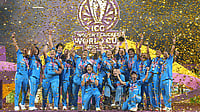Prime Minister Narendra Modi on Sunday asserted the significance of Sengol as a symbol of the transfer of power saying that the scepter will continue to inspire the parliamentarians in their duty.
In his address in the Lok Sabha chamber of the new Parliament to mark the inauguration of the building, Modi said the Sengol in 1947 symbolised of transfer of power under the guidance of Rajaji and the Adheenams.
On the contrary, Congress has been claiming that there has been no documented evidence of Lord Mountbatten, C Rajagopalachari, and Jawaharlal Nehru describing the scepter as a symbol of the transfer of power by the British to India.
"Recently, a lot of information related to its (Sengol's) history has come out in the media. I don't want to go into detail. But, I believe it is our good fortune that we have been able to restore the dignity of the sacred Sengol. Whenever proceedings begin in this Parliament House, Sengol will continue to inspire us all," Modi said.
After the Sengol was installed in Lok Sabha Sunday morning, he said, "In the great Chola Empire, Sengol was considered a symbol of the path of duty, the path of service, and the path of national service."
A ceremonial scepter, 'Sengol', which is said to have been given to India's first prime minister Jawaharlal Nehru to symbolise the transfer of power in August 1947 by the British, was kept in the Nehru Gallery of the Allahabad Museum and was installed in the Lok Sabha chamber of the new Parliament.
Made of silver with a coat of gold, Sengol was originally used to mark the handing over of power from one king to another during the Chola dynasty in Tamil Nadu.
Sengol Installed In Lok Sabha Will Continue To Inspire Us, Says PM Modi
On Sunday, Prime Minister Narendra Modi asserted the significance of Sengol as a symbol of the transfer of power saying that the scepter will continue to inspire the parliamentarians in their duty.

PM Modi receives Sengol
PM Modi receives Sengol
Published At:
MOST POPULAR
WATCH
MORE FROM THE AUTHOR
×





















